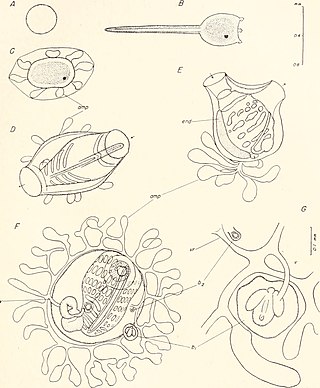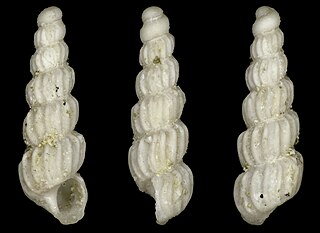Edward John Miers FZS FLS was a British zoologist and curator of the crustacean collection at the Natural History Museum in London. He contributed to the scientific reports from the Challenger expedition of 1872–1876, and described 32 new genera and at least 260 new species and subspecies of decapod crustaceans, along with four genera and 72 new species in other orders.

Typhlodaphne platamodes is a species of sea snail, a marine gastropod mollusk in the family Borsoniidae.

Paracuneus immaculatus is a species of sea snail, a marine gastropod mollusk in the family Drilliidae.
Coralliophila aedonia is a species of sea snail, a marine gastropod mollusk in the family Muricidae, the murex snails or rock snails.

Pandalosia ephamilla is a species of minute sea snail, a marine gastropod mollusc or micromollusc in the family Zebinidae.
Turbonilla kymatoessa is a species of sea snail, a marine gastropod mollusk in the family Pyramidellidae, the pyrams and their allies.

Cyclostrema subexcavatum is a species of sea snail, a marine gastropod mollusk in the family Liotiidae.
Anatoma aedonia is a species of minute sea snail, a marine gastropod mollusk or micromollusk in the family Anatomidae.
Satondella tabulata is a species of minute sea snail, a marine gastropod mollusk or micromollusk in the family Scissurellidae, the little slit snails.

Rossellidae is a family of glass sponges belonging to the order Lyssacinosa. The family has a cosmopolitan distribution and is found at a large range of depths.

Caulophacus is a genus of glass sponges belonging to the subfamily Lanuginellinae.
Cladogramma is an extinct genus of prehistoric marine diatoms with uncertain affinity. Species are known from the Pliocene of Japan, Miocene of the United States, Cretaceous and Paleocene of Antarctica.
Amphoriscus is a genus of calcareous sponges in the family Amphoriscidae.

Symplegma viride is a species of ascidian tunicates in the family Styelidae.
Acanthascus is a genus of sponges in the family Rossellidae. Species include:
Geodia cooksoni is a sponge species in the family Geodiidae. The species was first described by British scientist William Johnson Sollas in 1888 under the name Cydonium cooksoni. It is found in the waters of the Pacific Ocean around the Galápagos Islands.
Dasychalina fragilis is a species of sponge described by Stuart Oliver Ridley and Arthur Dendy in 1886. Dasychalina fragilis belongs to the genus Dasychalina and the family Niphatidae.

Marseniopsis is a genus of small slug-like sea snails, marine gastropod molluscs in the subfamily Velutininae within the family Velutinidae.

Sycozoa pulchra, is a sea squirt in the family Holozoidae, first described by William Abbott Herdman in 1886 as Colella pulchra. The taxonomic decision which determined the name, Sycozoa pulchra, and the species' synonymy was given by Patricia Kott in 1990.

Aclis minutissima is a species of sea snail, a marine gastropod mollusk in the family Eulimidae.











